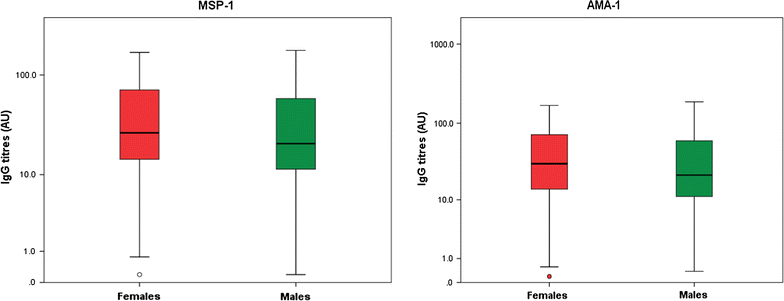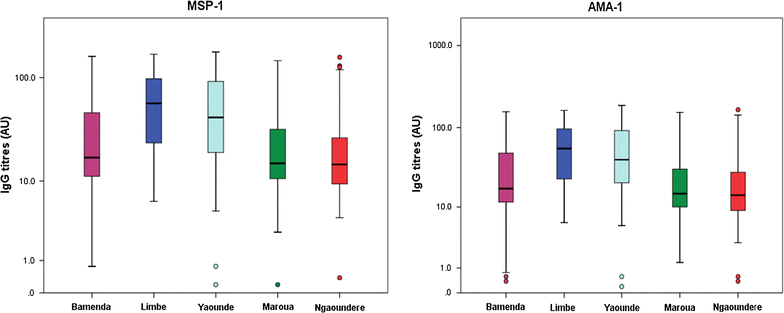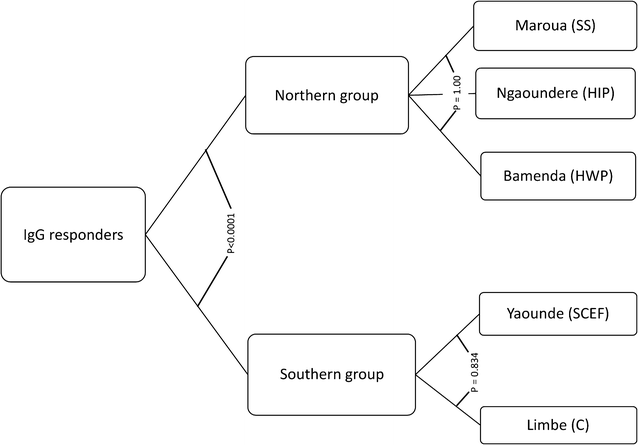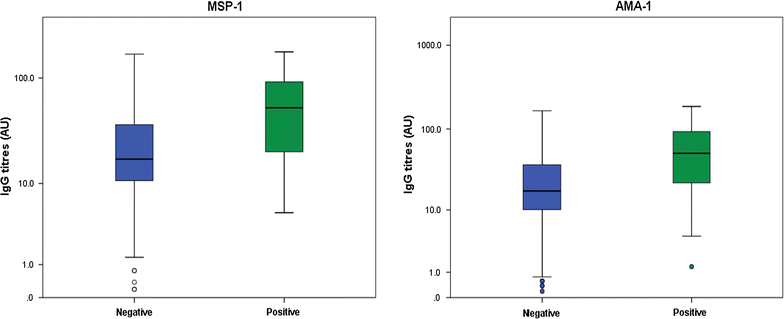Variation in the immune responses against Plasmodium falciparum merozoite surface protein-1 and apical membrane antigen-1 in children residing in the different epidemiological strata of malaria in Cameroon
- PMID: 29121929
- PMCID: PMC5679504
- DOI: 10.1186/s12936-017-2105-4
Variation in the immune responses against Plasmodium falciparum merozoite surface protein-1 and apical membrane antigen-1 in children residing in the different epidemiological strata of malaria in Cameroon
Abstract
Background: Studies to assess the immune responses against malaria in Cameroonian children are limited. The purpose of this study was to assess the immune responses against Plasmodium falciparum merozoite surface protein-1 (MSP-119) and apical membrane antigen-1 (AMA-1) in children residing in the different epidemiological strata of malaria in Cameroon.
Methods: In a cross-sectional survey performed between April and July 2015, 602 children between 2 and 15 years (mean ± SD = 5.7 ± 3.7), comprising 319 (53%) males were enrolled from five epidemiological strata of malaria in Cameroon including: the sudano-sahelian (SS) strata, the high inland plateau (HIP) strata, the south Cameroonian equatorial forest (SCEF) strata, the high western plateau (HWP) strata, and the coastal (C) strata. The children were screened for clinical malaria (defined by malaria parasitaemia ≥ 5000 parasites/µl plus axillary temperature ≥ 37.5 °C). Their antibody responses were measured against P. falciparum MSP-119 and AMA-1 vaccine candidate antigens using standard ELISA technique.
Results: A majority of the participants were IgG responders 72.1% (95% CI 68.3-75.6). The proportion of responders was higher in females (p = 0.002) and in children aged 10 years and above (p = 0.005). The proportion of responders was highest in Limbe (C strata) and lowest in Ngaoundere (HIP strata) (p < 0.0001). Similarly, the mean IgG antibody levels were higher in children aged 10 years and above (p < 0.0001) and in Limbe (p = 0.001). The IgG antibody levels against AMA-1 were higher in females (p = 0.028), meanwhile no gender disparity was observed with MSP-1. Furthermore the risk of clinical malaria (p < 0.0001) and the mean parasite density (p = 0.035) were higher in IgG non-responders.
Conclusion: A high proportion of IgG responders was observed in this study, suggesting a high degree exposure of the target population to malaria parasites. The immune responses varied considerably across the different strata: the highest levels observed in the C strata and the lowest in the HIP strata. Furthermore, malaria transmission in Cameroon could be categorized into two major groups based on the serological reaction of the children: the southern (comprising C and SCEF strata) and northern (comprising HWP, HIP and SS strata) groups. These findings may have significant implications in the design of future trials for evaluating malaria vaccine candidates in Cameroon.
Keywords: Apical membrane antigen-1; Cameroon; Children; ELISA; Epidemiological strata; Malaria immune responses; Merozoite surface protein-1; Plasmodium falciparum.
Figures






Similar articles
-
Comparative analysis of IgG and IgG subclasses against Plasmodium falciparum MSP-119 in children from five contrasting bioecological zones of Cameroon.Malar J. 2019 Jan 22;18(1):16. doi: 10.1186/s12936-019-2654-9. Malar J. 2019. PMID: 30670064 Free PMC article.
-
Epidemiological and clinical profile of paediatric malaria: a cross sectional study performed on febrile children in five epidemiological strata of malaria in Cameroon.BMC Infect Dis. 2017 Jul 17;17(1):499. doi: 10.1186/s12879-017-2587-2. BMC Infect Dis. 2017. PMID: 28716002 Free PMC article.
-
Comparative analysis of the profiles of IgG subclass-specific responses to Plasmodium falciparum apical membrane antigen-1 and merozoite surface protein-1 in naturally exposed individuals living in malaria hypoendemic settings, Iran.Malar J. 2015 Feb 5;14:58. doi: 10.1186/s12936-015-0547-0. Malar J. 2015. PMID: 25652589 Free PMC article.
-
Towards an RTS,S-based, multi-stage, multi-antigen vaccine against falciparum malaria: progress at the Walter Reed Army Institute of Research.Vaccine. 2005 Mar 18;23(17-18):2243-50. doi: 10.1016/j.vaccine.2005.01.142. Vaccine. 2005. PMID: 15755604 Review.
-
Opinion: antibody-based therapies for malaria.Nat Rev Microbiol. 2005 Nov;3(11):893-9. doi: 10.1038/nrmicro1267. Nat Rev Microbiol. 2005. PMID: 16261172 Review.
Cited by
-
Practical example of multiple antibody screening for evaluation of malaria control strategies.Malar J. 2020 Mar 19;19(1):117. doi: 10.1186/s12936-020-03186-9. Malar J. 2020. PMID: 32192514 Free PMC article.
-
Malaria and HIV coinfection in sub-Saharan Africa: prevalence, impact, and treatment strategies.Res Rep Trop Med. 2018 Jul 27;9:123-136. doi: 10.2147/RRTM.S154501. eCollection 2018. Res Rep Trop Med. 2018. PMID: 30100779 Free PMC article. Review.
-
Seroepidemiological surveillance, community perceptions and associated risk factors of malaria exposure among forest-goers in Northeastern Thailand.Front Cell Infect Microbiol. 2022 Aug 22;12:953585. doi: 10.3389/fcimb.2022.953585. eCollection 2022. Front Cell Infect Microbiol. 2022. PMID: 36093204 Free PMC article.
-
Genetic diversity and allele frequencies of Plasmodium falciparum msp1 and msp2 in parasite isolates from Bioko Island, Equatorial Guinea.Malar J. 2018 Dec 7;17(1):458. doi: 10.1186/s12936-018-2611-z. Malar J. 2018. PMID: 30526609 Free PMC article.
-
Serology reveals comparable patterns in the transmission intensities of Plasmodium falciparum and Plasmodium vivax in Langkat district, North Sumatera Province, Indonesia.Front Cell Infect Microbiol. 2025 Feb 17;15:1504741. doi: 10.3389/fcimb.2025.1504741. eCollection 2025. Front Cell Infect Microbiol. 2025. PMID: 40034395 Free PMC article.
References
-
- WHO. World malaria report 2011. Geneva: World Health Organization; 2011. http://www.who.int/malaria/world_malaria_report_2011/en/index.html.
-
- Antonio-Nkondjio C, Demanou M, Etang J, Bouchite B. Impact of cyfluthrin (Solfac EW050) impregnated bed nets on malaria transmission in the city of Mbandjock: lessons for the nationwide distribution of long-lasting insecticidal nets (LLINs) in Cameroon. Parasit Vectors. 2013;6:10. doi: 10.1186/1756-3305-6-10. - DOI - PMC - PubMed
MeSH terms
Substances
LinkOut - more resources
Full Text Sources
Other Literature Sources
Medical
Research Materials
Miscellaneous

